University Microeconomics Principles Assignment: ECON111, S2 2018
VerifiedAdded on 2023/06/04
|15
|2048
|50
Homework Assignment
AI Summary
This assignment analyzes microeconomic principles, focusing on the impact of minimum wage on the labor market. It begins by defining minimum wage and its binding nature, then presents supply and demand curves for unskilled labor, calculating equilibrium wage and quantity. The assignment proceeds to analyze consumer and producer surplus, and the impact of a minimum wage on these surpluses, the labor surplus, and the total economic surplus. The analysis includes calculations of deadweight loss and resource costs. The assignment also explores the effects of minimum wage on firms, workers, and overall welfare, and discusses allocative efficiency in relation to minimum wage policies. The assignment concludes with a comparison of free market equilibrium and the minimum wage's impact on social welfare and addresses the ethical implications of minimum wage policies.
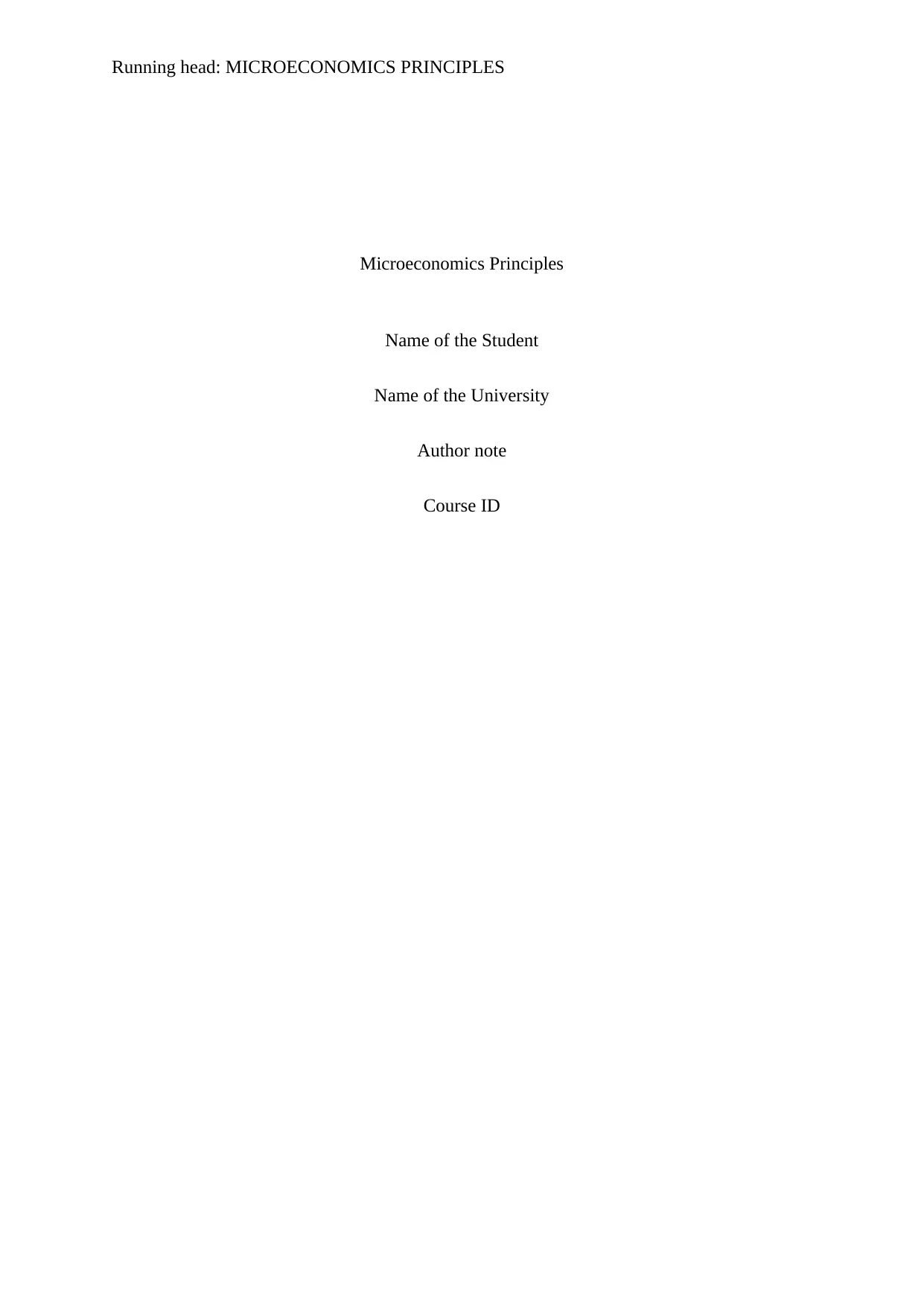
Running head: MICROECONOMICS PRINCIPLES
Microeconomics Principles
Name of the Student
Name of the University
Author note
Course ID
Microeconomics Principles
Name of the Student
Name of the University
Author note
Course ID
Paraphrase This Document
Need a fresh take? Get an instant paraphrase of this document with our AI Paraphraser
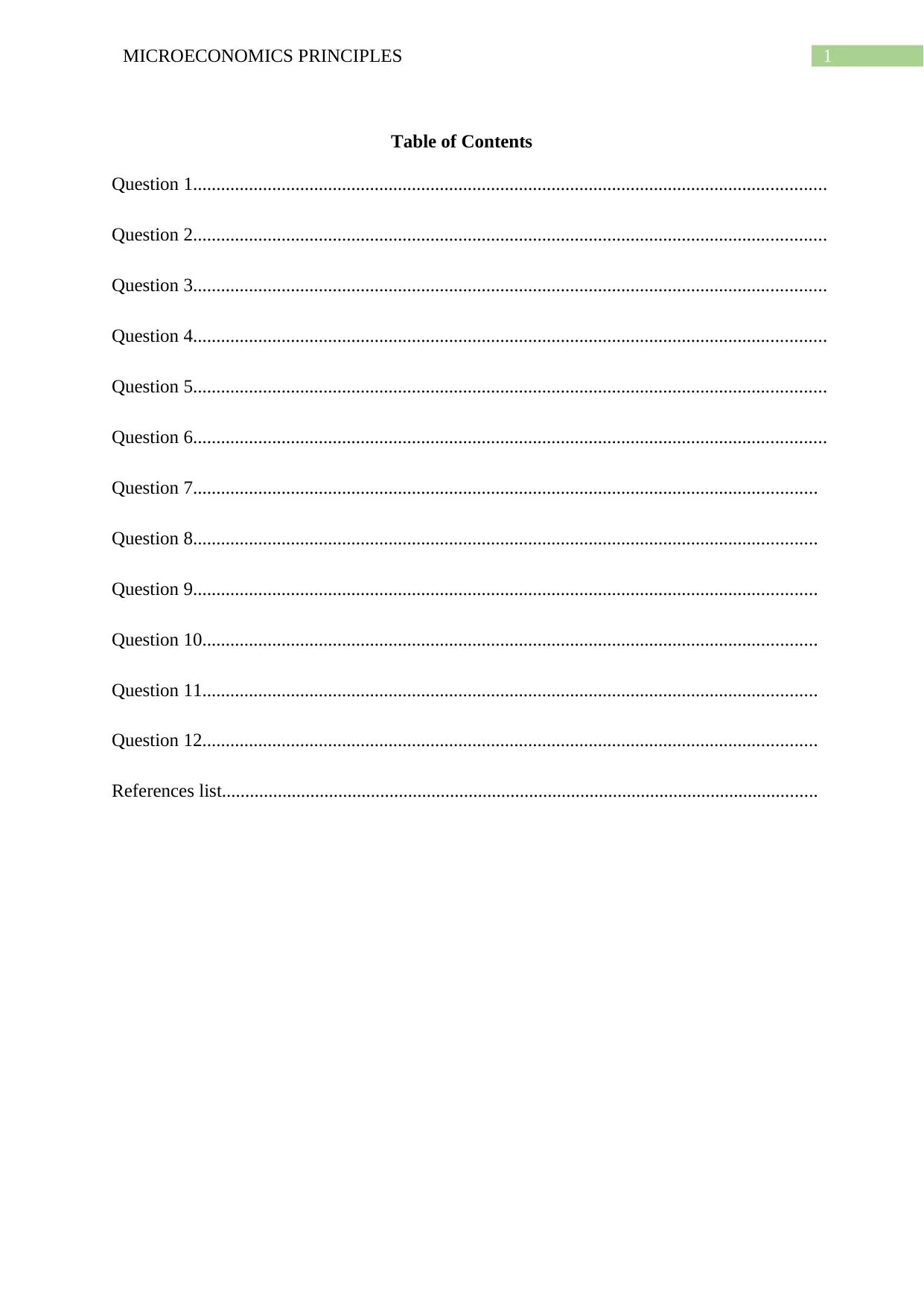
1MICROECONOMICS PRINCIPLES
Table of Contents
Question 1........................................................................................................................................
Question 2........................................................................................................................................
Question 3........................................................................................................................................
Question 4........................................................................................................................................
Question 5........................................................................................................................................
Question 6........................................................................................................................................
Question 7......................................................................................................................................
Question 8......................................................................................................................................
Question 9......................................................................................................................................
Question 10....................................................................................................................................
Question 11....................................................................................................................................
Question 12....................................................................................................................................
References list................................................................................................................................
Table of Contents
Question 1........................................................................................................................................
Question 2........................................................................................................................................
Question 3........................................................................................................................................
Question 4........................................................................................................................................
Question 5........................................................................................................................................
Question 6........................................................................................................................................
Question 7......................................................................................................................................
Question 8......................................................................................................................................
Question 9......................................................................................................................................
Question 10....................................................................................................................................
Question 11....................................................................................................................................
Question 12....................................................................................................................................
References list................................................................................................................................
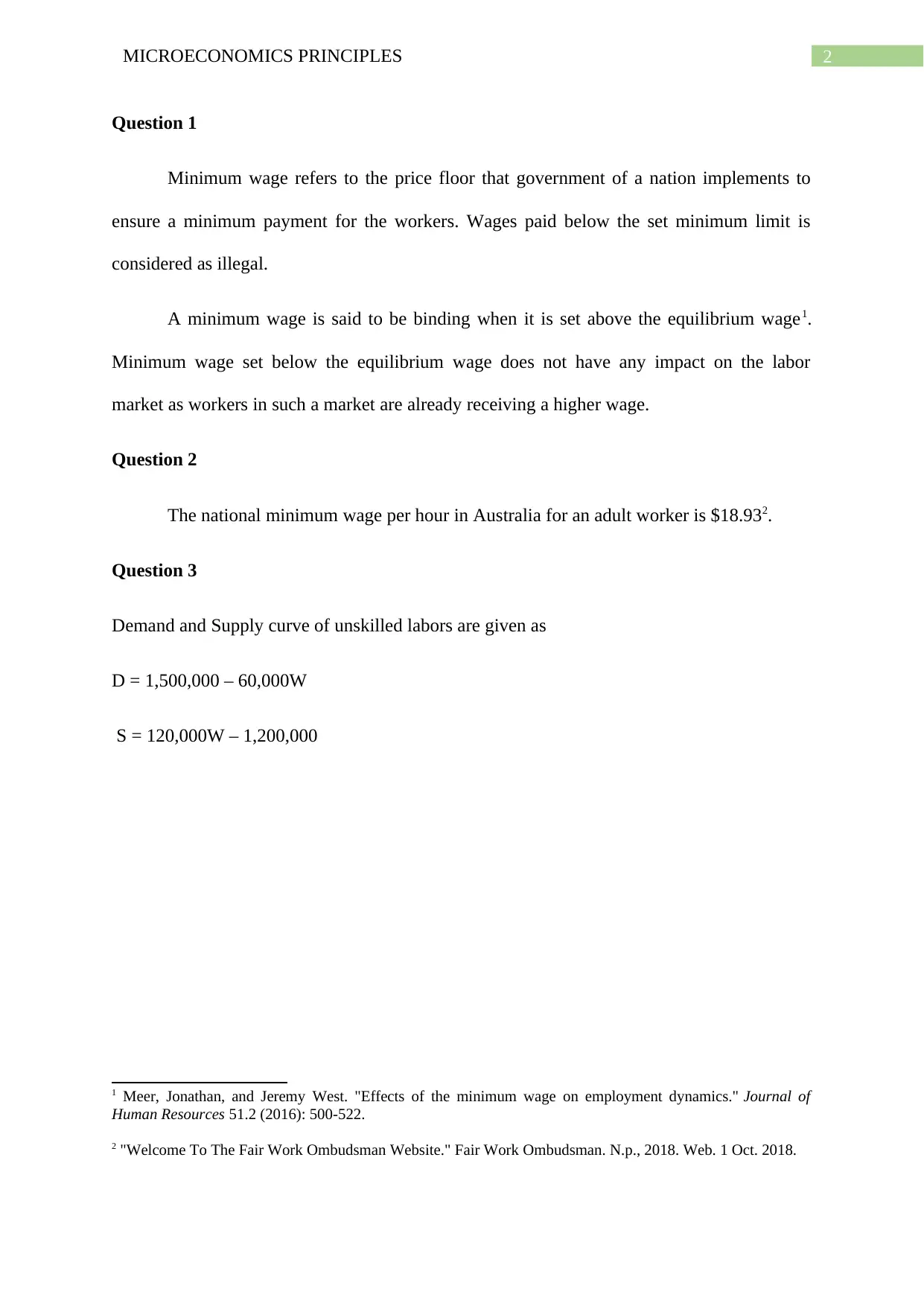
2MICROECONOMICS PRINCIPLES
Question 1
Minimum wage refers to the price floor that government of a nation implements to
ensure a minimum payment for the workers. Wages paid below the set minimum limit is
considered as illegal.
A minimum wage is said to be binding when it is set above the equilibrium wage1.
Minimum wage set below the equilibrium wage does not have any impact on the labor
market as workers in such a market are already receiving a higher wage.
Question 2
The national minimum wage per hour in Australia for an adult worker is $18.932.
Question 3
Demand and Supply curve of unskilled labors are given as
D = 1,500,000 – 60,000W
S = 120,000W – 1,200,000
1 Meer, Jonathan, and Jeremy West. "Effects of the minimum wage on employment dynamics." Journal of
Human Resources 51.2 (2016): 500-522.
2 "Welcome To The Fair Work Ombudsman Website." Fair Work Ombudsman. N.p., 2018. Web. 1 Oct. 2018.
Question 1
Minimum wage refers to the price floor that government of a nation implements to
ensure a minimum payment for the workers. Wages paid below the set minimum limit is
considered as illegal.
A minimum wage is said to be binding when it is set above the equilibrium wage1.
Minimum wage set below the equilibrium wage does not have any impact on the labor
market as workers in such a market are already receiving a higher wage.
Question 2
The national minimum wage per hour in Australia for an adult worker is $18.932.
Question 3
Demand and Supply curve of unskilled labors are given as
D = 1,500,000 – 60,000W
S = 120,000W – 1,200,000
1 Meer, Jonathan, and Jeremy West. "Effects of the minimum wage on employment dynamics." Journal of
Human Resources 51.2 (2016): 500-522.
2 "Welcome To The Fair Work Ombudsman Website." Fair Work Ombudsman. N.p., 2018. Web. 1 Oct. 2018.
⊘ This is a preview!⊘
Do you want full access?
Subscribe today to unlock all pages.

Trusted by 1+ million students worldwide
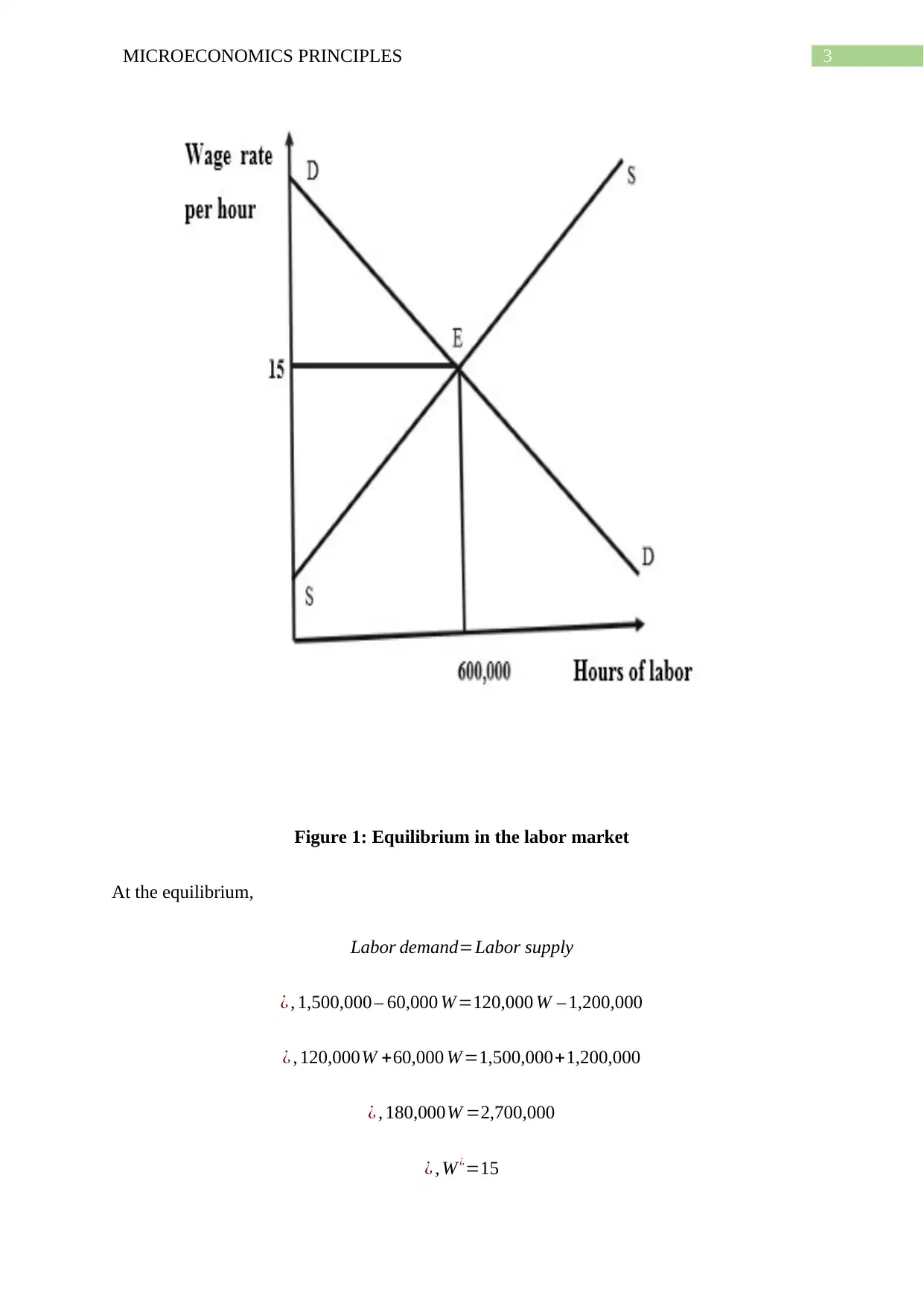
3MICROECONOMICS PRINCIPLES
Figure 1: Equilibrium in the labor market
At the equilibrium,
Labor demand=Labor supply
¿ , 1,500,000 – 60,000 W=120,000 W – 1,200,000
¿ , 120,000W +60,000 W =1,500,000+1,200,000
¿ , 180,000W =2,700,000
¿ , W¿=15
Figure 1: Equilibrium in the labor market
At the equilibrium,
Labor demand=Labor supply
¿ , 1,500,000 – 60,000 W=120,000 W – 1,200,000
¿ , 120,000W +60,000 W =1,500,000+1,200,000
¿ , 180,000W =2,700,000
¿ , W¿=15
Paraphrase This Document
Need a fresh take? Get an instant paraphrase of this document with our AI Paraphraser
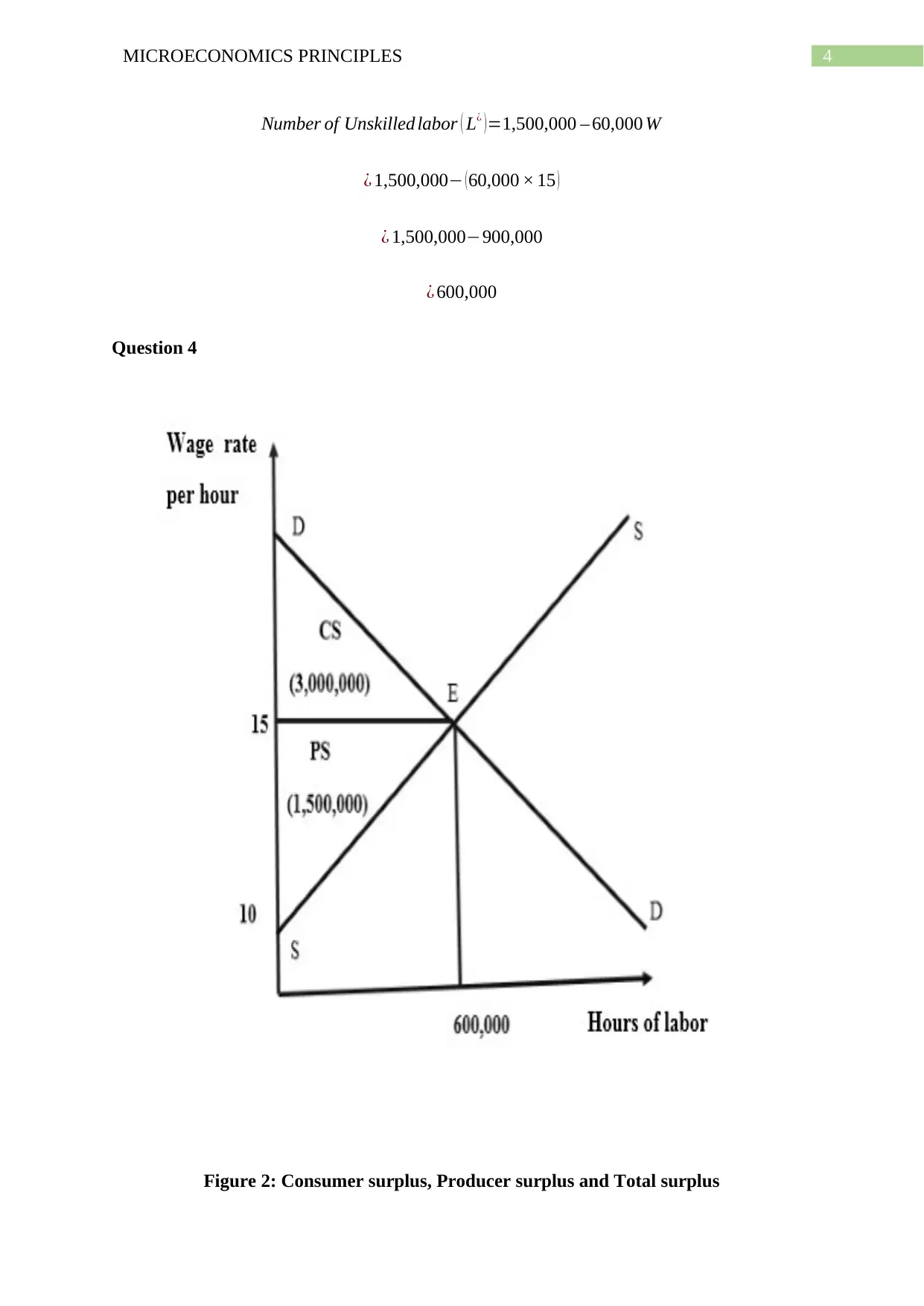
4MICROECONOMICS PRINCIPLES
Number of Unskilled labor ( L¿ ) =1,500,000 – 60,000 W
¿ 1,500,000− ( 60,000 × 15 )
¿ 1,500,000−900,000
¿ 600,000
Question 4
Figure 2: Consumer surplus, Producer surplus and Total surplus
Number of Unskilled labor ( L¿ ) =1,500,000 – 60,000 W
¿ 1,500,000− ( 60,000 × 15 )
¿ 1,500,000−900,000
¿ 600,000
Question 4
Figure 2: Consumer surplus, Producer surplus and Total surplus
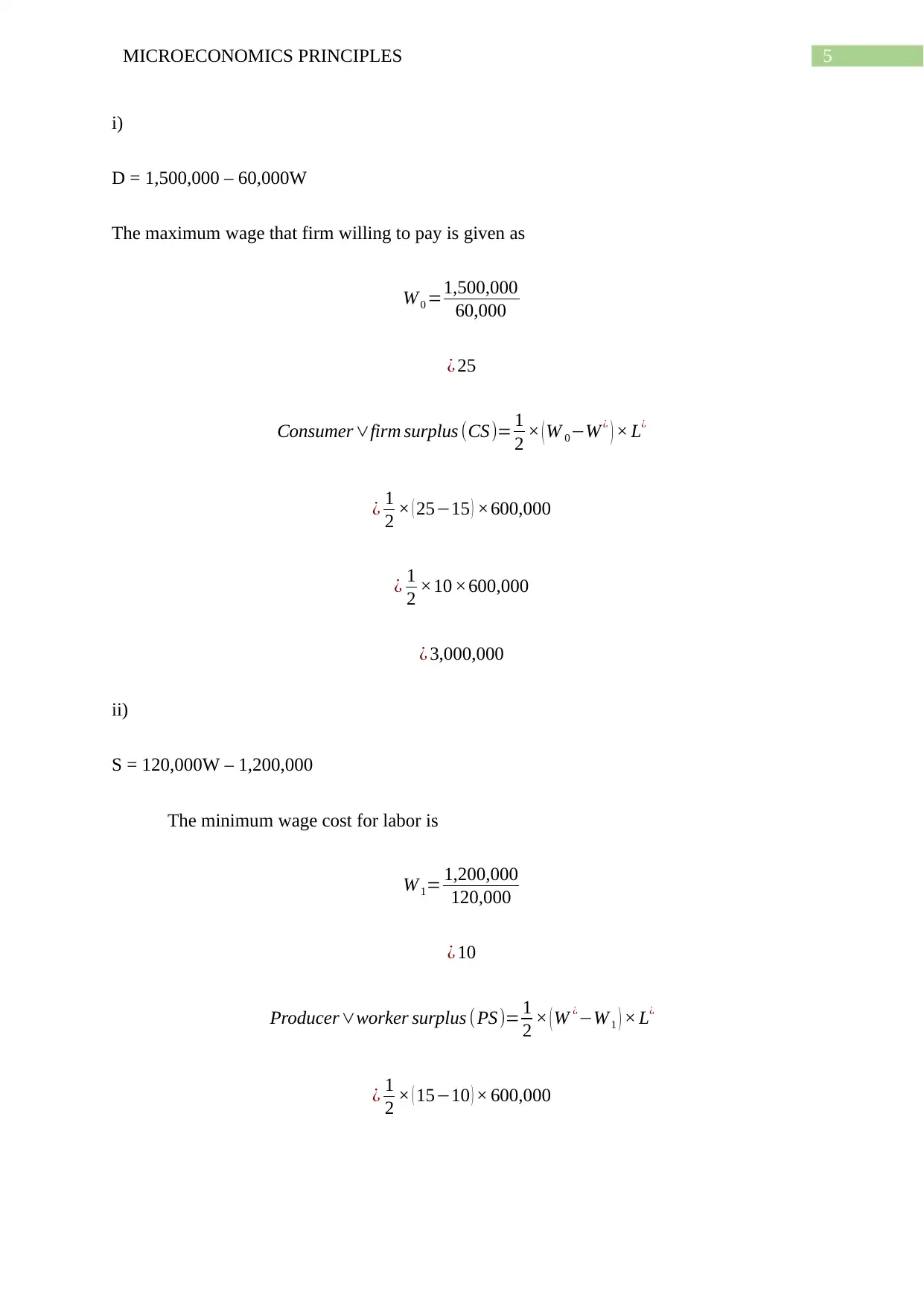
5MICROECONOMICS PRINCIPLES
i)
D = 1,500,000 – 60,000W
The maximum wage that firm willing to pay is given as
W0 =1,500,000
60,000
¿ 25
Consumer∨firm surplus (CS)= 1
2 × ( W 0−W ¿
) × L¿
¿ 1
2 × ( 25−15 ) ×600,000
¿ 1
2 ×10 ×600,000
¿ 3,000,000
ii)
S = 120,000W – 1,200,000
The minimum wage cost for labor is
W 1= 1,200,000
120,000
¿ 10
Producer∨worker surplus (PS)= 1
2 × (W ¿−W 1 ) × L¿
¿ 1
2 × ( 15−10 ) × 600,000
i)
D = 1,500,000 – 60,000W
The maximum wage that firm willing to pay is given as
W0 =1,500,000
60,000
¿ 25
Consumer∨firm surplus (CS)= 1
2 × ( W 0−W ¿
) × L¿
¿ 1
2 × ( 25−15 ) ×600,000
¿ 1
2 ×10 ×600,000
¿ 3,000,000
ii)
S = 120,000W – 1,200,000
The minimum wage cost for labor is
W 1= 1,200,000
120,000
¿ 10
Producer∨worker surplus (PS)= 1
2 × (W ¿−W 1 ) × L¿
¿ 1
2 × ( 15−10 ) × 600,000
⊘ This is a preview!⊘
Do you want full access?
Subscribe today to unlock all pages.

Trusted by 1+ million students worldwide
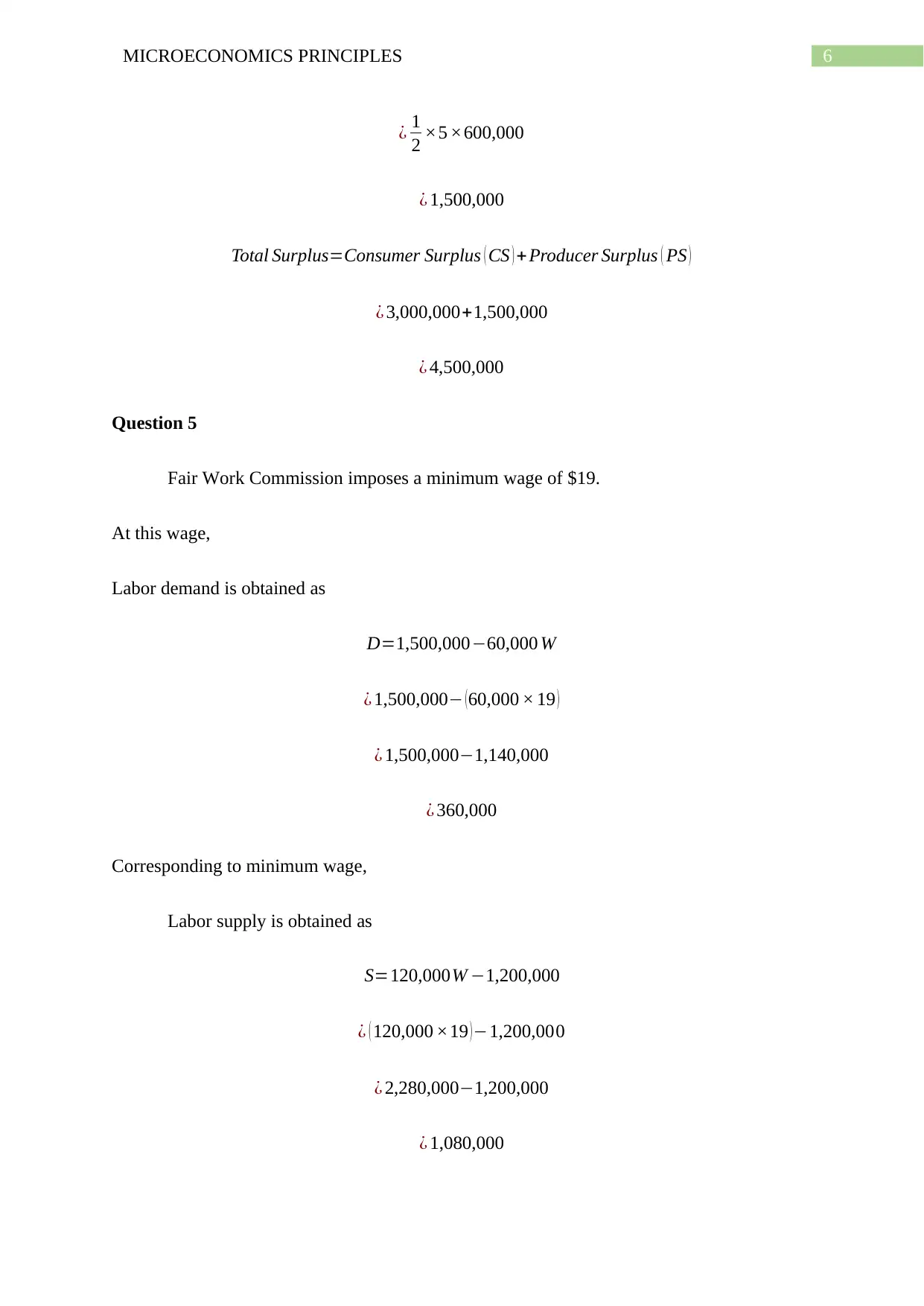
6MICROECONOMICS PRINCIPLES
¿ 1
2 ×5 ×600,000
¿ 1,500,000
Total Surplus=Consumer Surplus ( CS ) + Producer Surplus ( PS )
¿ 3,000,000+1,500,000
¿ 4,500,000
Question 5
Fair Work Commission imposes a minimum wage of $19.
At this wage,
Labor demand is obtained as
D=1,500,000−60,000 W
¿ 1,500,000− (60,000 × 19 )
¿ 1,500,000−1,140,000
¿ 360,000
Corresponding to minimum wage,
Labor supply is obtained as
S=120,000W −1,200,000
¿ ( 120,000 ×19 )−1,200,000
¿ 2,280,000−1,200,000
¿ 1,080,000
¿ 1
2 ×5 ×600,000
¿ 1,500,000
Total Surplus=Consumer Surplus ( CS ) + Producer Surplus ( PS )
¿ 3,000,000+1,500,000
¿ 4,500,000
Question 5
Fair Work Commission imposes a minimum wage of $19.
At this wage,
Labor demand is obtained as
D=1,500,000−60,000 W
¿ 1,500,000− (60,000 × 19 )
¿ 1,500,000−1,140,000
¿ 360,000
Corresponding to minimum wage,
Labor supply is obtained as
S=120,000W −1,200,000
¿ ( 120,000 ×19 )−1,200,000
¿ 2,280,000−1,200,000
¿ 1,080,000
Paraphrase This Document
Need a fresh take? Get an instant paraphrase of this document with our AI Paraphraser
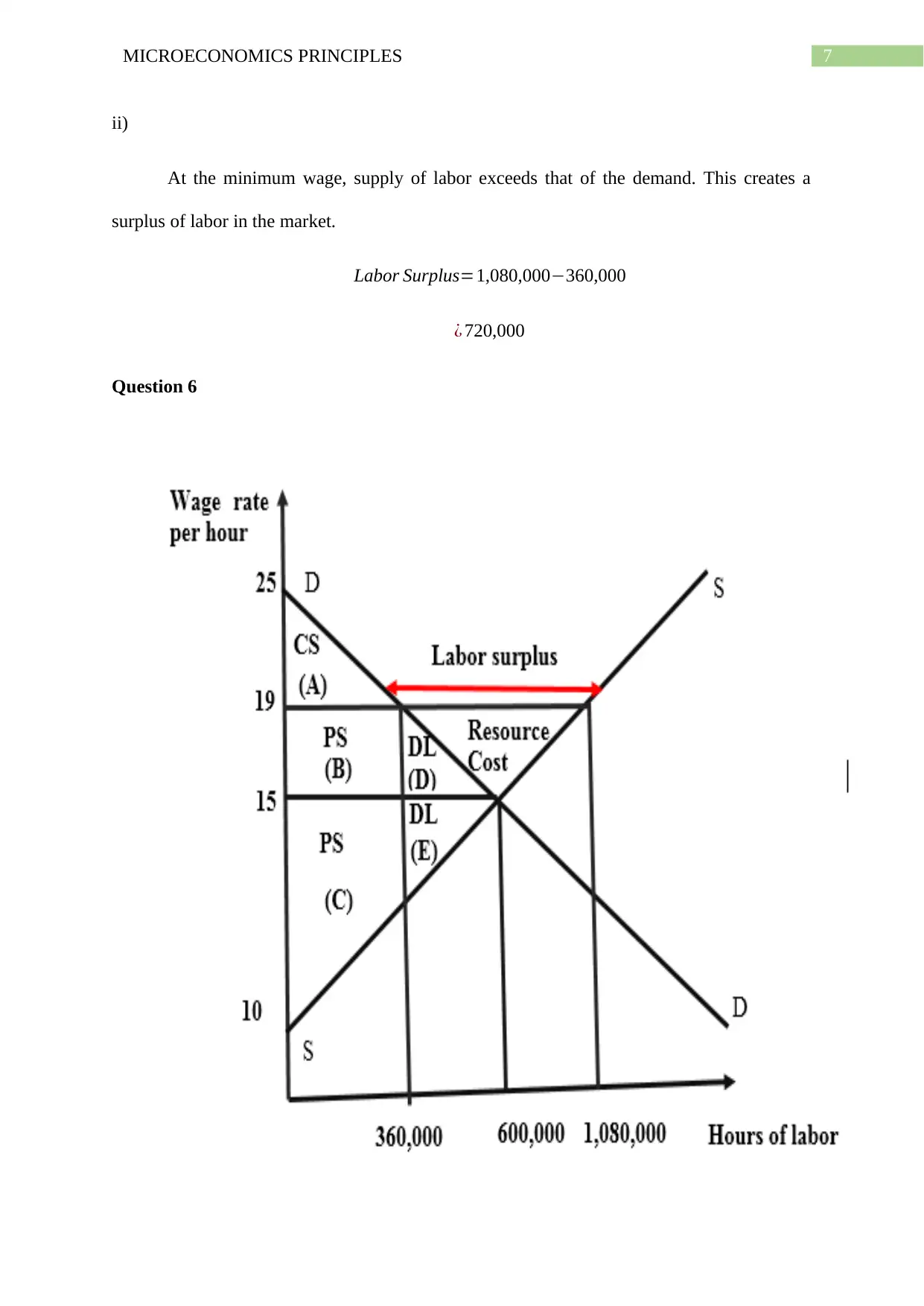
7MICROECONOMICS PRINCIPLES
ii)
At the minimum wage, supply of labor exceeds that of the demand. This creates a
surplus of labor in the market.
Labor Surplus=1,080,000−360,000
¿ 720,000
Question 6
ii)
At the minimum wage, supply of labor exceeds that of the demand. This creates a
surplus of labor in the market.
Labor Surplus=1,080,000−360,000
¿ 720,000
Question 6
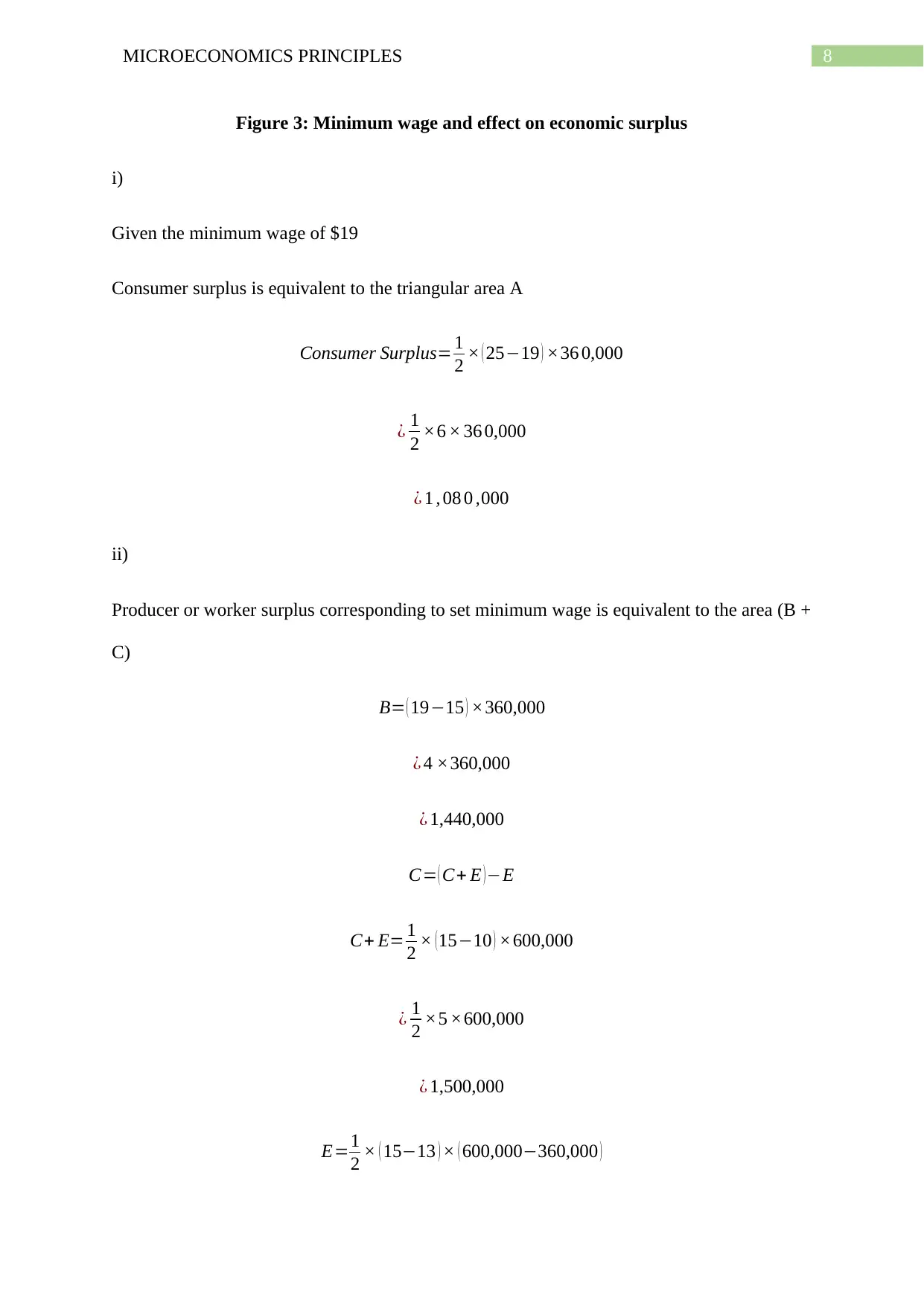
8MICROECONOMICS PRINCIPLES
Figure 3: Minimum wage and effect on economic surplus
i)
Given the minimum wage of $19
Consumer surplus is equivalent to the triangular area A
Consumer Surplus= 1
2 × ( 25−19 ) ×36 0,000
¿ 1
2 ×6 × 36 0,000
¿ 1 , 08 0 ,000
ii)
Producer or worker surplus corresponding to set minimum wage is equivalent to the area (B +
C)
B= ( 19−15 ) ×360,000
¿ 4 ×360,000
¿ 1,440,000
C= ( C+ E ) −E
C+ E= 1
2 × (15−10 ) ×600,000
¿ 1
2 ×5 ×600,000
¿ 1,500,000
E=1
2 × ( 15−13 ) × ( 600,000−360,000 )
Figure 3: Minimum wage and effect on economic surplus
i)
Given the minimum wage of $19
Consumer surplus is equivalent to the triangular area A
Consumer Surplus= 1
2 × ( 25−19 ) ×36 0,000
¿ 1
2 ×6 × 36 0,000
¿ 1 , 08 0 ,000
ii)
Producer or worker surplus corresponding to set minimum wage is equivalent to the area (B +
C)
B= ( 19−15 ) ×360,000
¿ 4 ×360,000
¿ 1,440,000
C= ( C+ E ) −E
C+ E= 1
2 × (15−10 ) ×600,000
¿ 1
2 ×5 ×600,000
¿ 1,500,000
E=1
2 × ( 15−13 ) × ( 600,000−360,000 )
⊘ This is a preview!⊘
Do you want full access?
Subscribe today to unlock all pages.

Trusted by 1+ million students worldwide
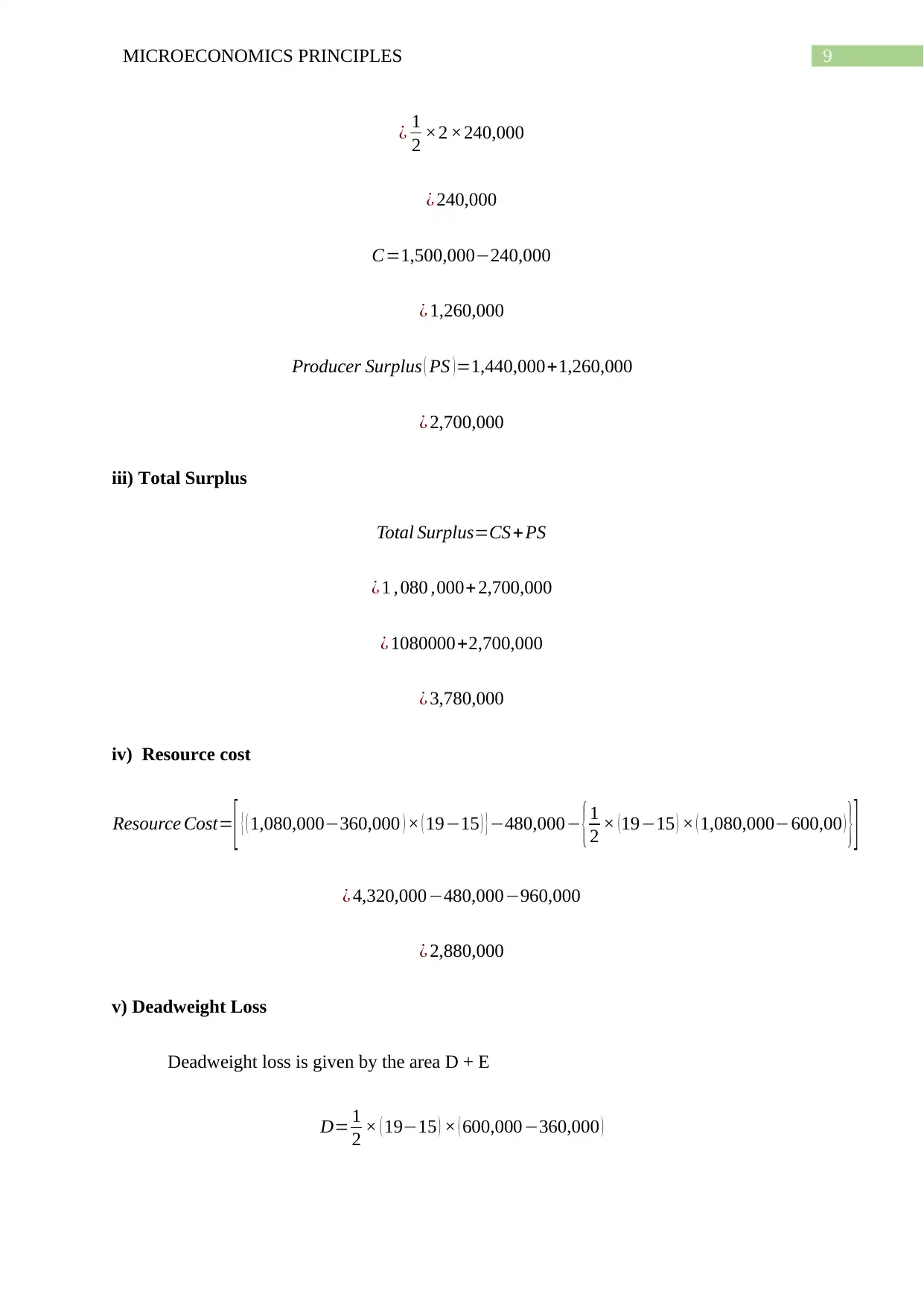
9MICROECONOMICS PRINCIPLES
¿ 1
2 ×2 ×240,000
¿ 240,000
C=1,500,000−240,000
¿ 1,260,000
Producer Surplus ( PS )=1,440,000+1,260,000
¿ 2,700,000
iii) Total Surplus
Total Surplus=CS+ PS
¿ 1 , 080 ,000+2,700,000
¿ 1080000+2,700,000
¿ 3,780,000
iv) Resource cost
Resource Cost= [ { ( 1,080,000−360,000 ) × ( 19−15 ) }−480,000− {1
2 × (19−15 ) × ( 1,080,000−600,00 ) }]
¿ 4,320,000−480,000−960,000
¿ 2,880,000
v) Deadweight Loss
Deadweight loss is given by the area D + E
D= 1
2 × ( 19−15 ) × ( 600,000−360,000 )
¿ 1
2 ×2 ×240,000
¿ 240,000
C=1,500,000−240,000
¿ 1,260,000
Producer Surplus ( PS )=1,440,000+1,260,000
¿ 2,700,000
iii) Total Surplus
Total Surplus=CS+ PS
¿ 1 , 080 ,000+2,700,000
¿ 1080000+2,700,000
¿ 3,780,000
iv) Resource cost
Resource Cost= [ { ( 1,080,000−360,000 ) × ( 19−15 ) }−480,000− {1
2 × (19−15 ) × ( 1,080,000−600,00 ) }]
¿ 4,320,000−480,000−960,000
¿ 2,880,000
v) Deadweight Loss
Deadweight loss is given by the area D + E
D= 1
2 × ( 19−15 ) × ( 600,000−360,000 )
Paraphrase This Document
Need a fresh take? Get an instant paraphrase of this document with our AI Paraphraser
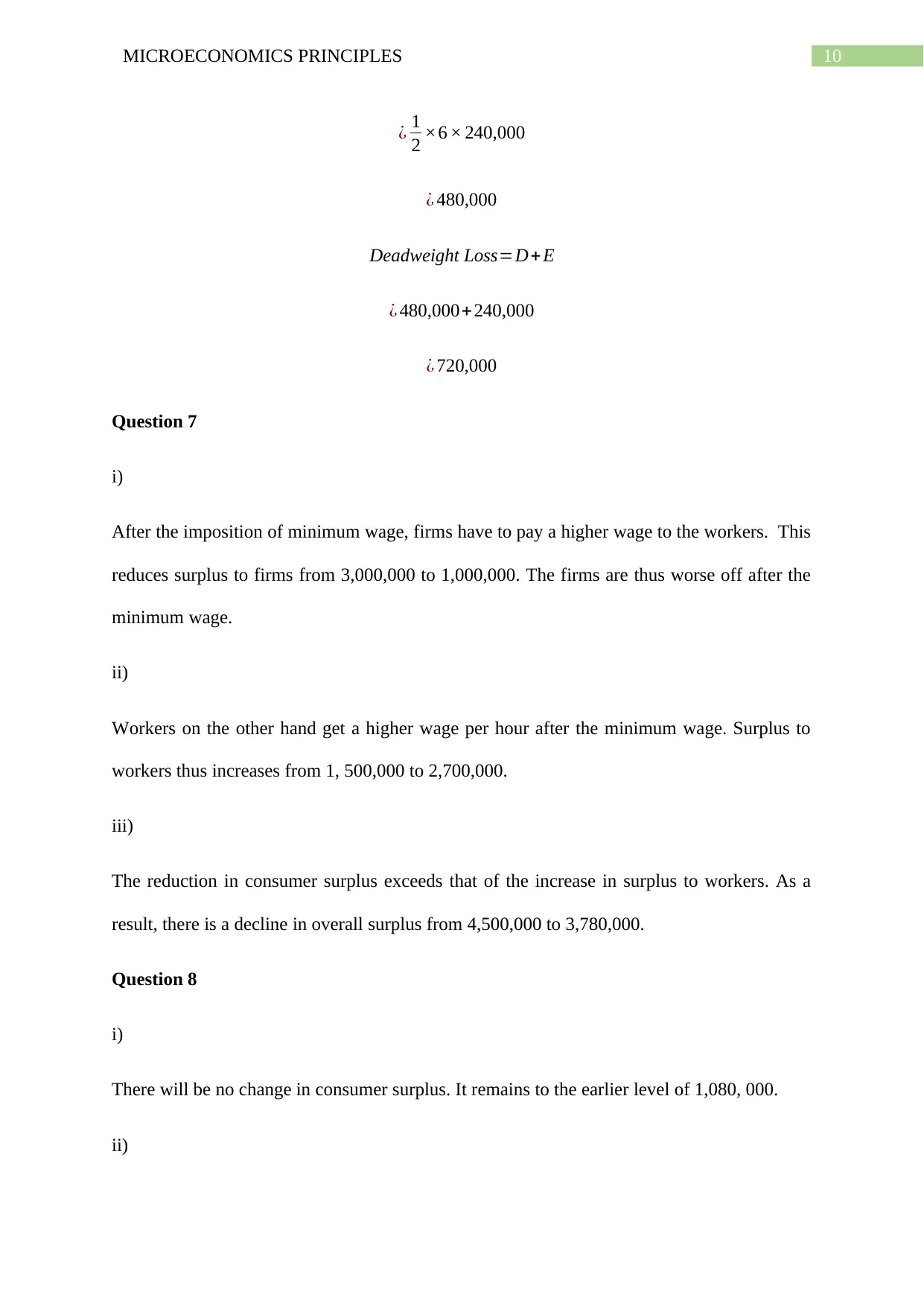
10MICROECONOMICS PRINCIPLES
¿ 1
2 ×6 × 240,000
¿ 480,000
Deadweight Loss=D+ E
¿ 480,000+240,000
¿ 720,000
Question 7
i)
After the imposition of minimum wage, firms have to pay a higher wage to the workers. This
reduces surplus to firms from 3,000,000 to 1,000,000. The firms are thus worse off after the
minimum wage.
ii)
Workers on the other hand get a higher wage per hour after the minimum wage. Surplus to
workers thus increases from 1, 500,000 to 2,700,000.
iii)
The reduction in consumer surplus exceeds that of the increase in surplus to workers. As a
result, there is a decline in overall surplus from 4,500,000 to 3,780,000.
Question 8
i)
There will be no change in consumer surplus. It remains to the earlier level of 1,080, 000.
ii)
¿ 1
2 ×6 × 240,000
¿ 480,000
Deadweight Loss=D+ E
¿ 480,000+240,000
¿ 720,000
Question 7
i)
After the imposition of minimum wage, firms have to pay a higher wage to the workers. This
reduces surplus to firms from 3,000,000 to 1,000,000. The firms are thus worse off after the
minimum wage.
ii)
Workers on the other hand get a higher wage per hour after the minimum wage. Surplus to
workers thus increases from 1, 500,000 to 2,700,000.
iii)
The reduction in consumer surplus exceeds that of the increase in surplus to workers. As a
result, there is a decline in overall surplus from 4,500,000 to 3,780,000.
Question 8
i)
There will be no change in consumer surplus. It remains to the earlier level of 1,080, 000.
ii)
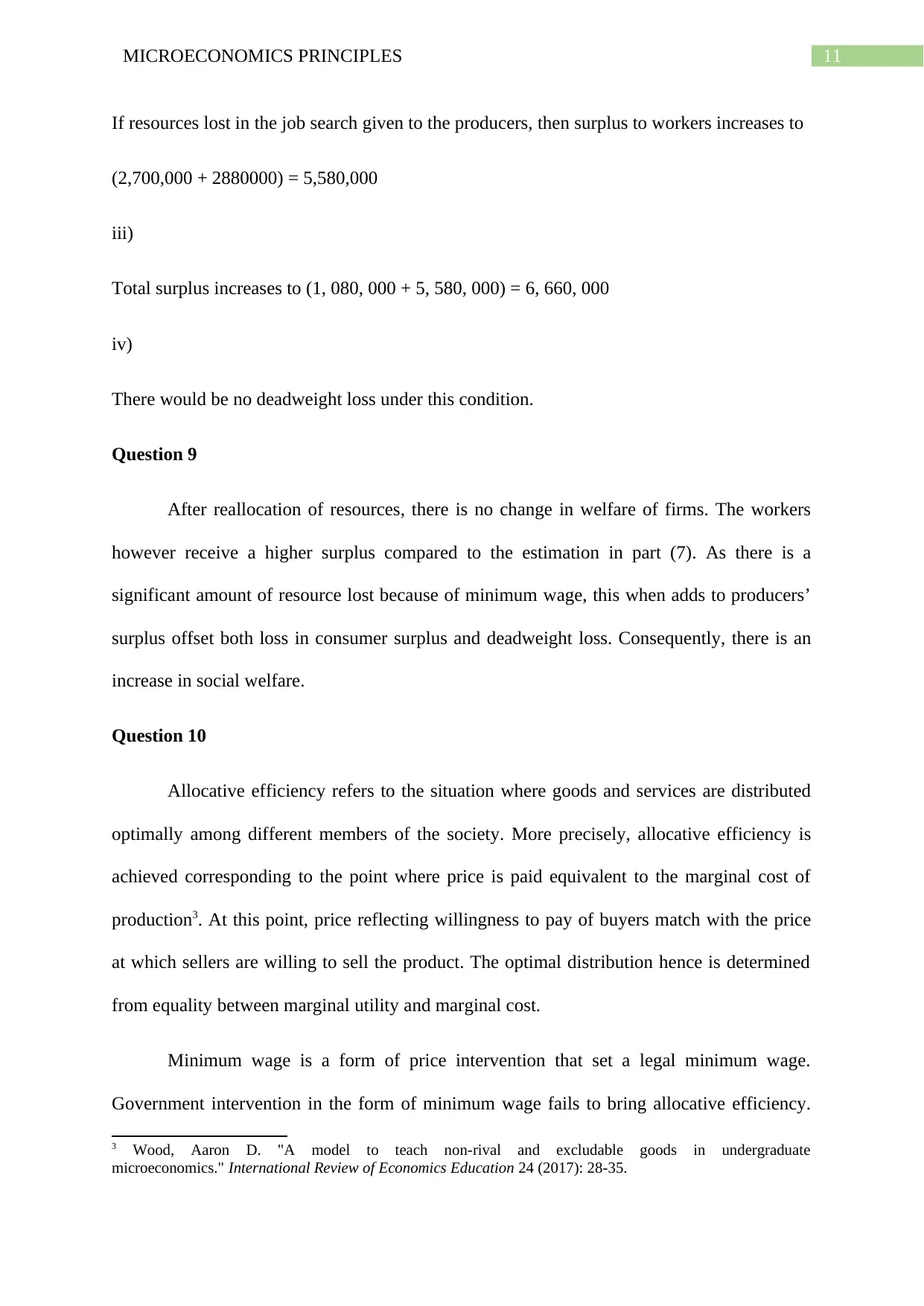
11MICROECONOMICS PRINCIPLES
If resources lost in the job search given to the producers, then surplus to workers increases to
(2,700,000 + 2880000) = 5,580,000
iii)
Total surplus increases to (1, 080, 000 + 5, 580, 000) = 6, 660, 000
iv)
There would be no deadweight loss under this condition.
Question 9
After reallocation of resources, there is no change in welfare of firms. The workers
however receive a higher surplus compared to the estimation in part (7). As there is a
significant amount of resource lost because of minimum wage, this when adds to producers’
surplus offset both loss in consumer surplus and deadweight loss. Consequently, there is an
increase in social welfare.
Question 10
Allocative efficiency refers to the situation where goods and services are distributed
optimally among different members of the society. More precisely, allocative efficiency is
achieved corresponding to the point where price is paid equivalent to the marginal cost of
production3. At this point, price reflecting willingness to pay of buyers match with the price
at which sellers are willing to sell the product. The optimal distribution hence is determined
from equality between marginal utility and marginal cost.
Minimum wage is a form of price intervention that set a legal minimum wage.
Government intervention in the form of minimum wage fails to bring allocative efficiency.
3 Wood, Aaron D. "A model to teach non-rival and excludable goods in undergraduate
microeconomics." International Review of Economics Education 24 (2017): 28-35.
If resources lost in the job search given to the producers, then surplus to workers increases to
(2,700,000 + 2880000) = 5,580,000
iii)
Total surplus increases to (1, 080, 000 + 5, 580, 000) = 6, 660, 000
iv)
There would be no deadweight loss under this condition.
Question 9
After reallocation of resources, there is no change in welfare of firms. The workers
however receive a higher surplus compared to the estimation in part (7). As there is a
significant amount of resource lost because of minimum wage, this when adds to producers’
surplus offset both loss in consumer surplus and deadweight loss. Consequently, there is an
increase in social welfare.
Question 10
Allocative efficiency refers to the situation where goods and services are distributed
optimally among different members of the society. More precisely, allocative efficiency is
achieved corresponding to the point where price is paid equivalent to the marginal cost of
production3. At this point, price reflecting willingness to pay of buyers match with the price
at which sellers are willing to sell the product. The optimal distribution hence is determined
from equality between marginal utility and marginal cost.
Minimum wage is a form of price intervention that set a legal minimum wage.
Government intervention in the form of minimum wage fails to bring allocative efficiency.
3 Wood, Aaron D. "A model to teach non-rival and excludable goods in undergraduate
microeconomics." International Review of Economics Education 24 (2017): 28-35.
⊘ This is a preview!⊘
Do you want full access?
Subscribe today to unlock all pages.

Trusted by 1+ million students worldwide
1 out of 15
Related Documents
Your All-in-One AI-Powered Toolkit for Academic Success.
+13062052269
info@desklib.com
Available 24*7 on WhatsApp / Email
![[object Object]](/_next/static/media/star-bottom.7253800d.svg)
Unlock your academic potential
Copyright © 2020–2025 A2Z Services. All Rights Reserved. Developed and managed by ZUCOL.



